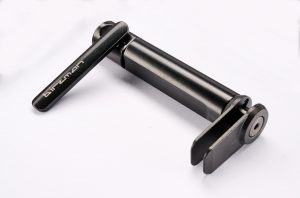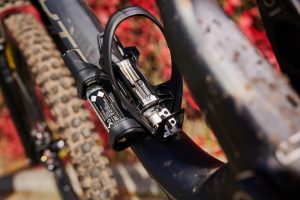The best tubeless sealant will keep the air in your tyre for longer and actually fix punctures while you ride. No more inner tubes or patches!
Ditching your inner tubes and converting to tubeless is one of the most transformative upgrades in mountain biking. And since modern rims and tyres are usually ‘tubeless ready’, most new bikes already have all the pieces of the puzzle in the box. In fact, the only things you’ll have to buy are a couple of tubeless valves and a bottle of sealant.
Just what is the best tubeless sealant out there? We put several mountain bike tubeless sealants through the slash test to rate their puncture powers. Tyre sealant seals punctures but in a tubeless system it also has another function – it coats the inside of the tyre, creating a barrier against air loss. This is because tubeless ready tyres are not fully air tight and eventually leak air through the casing.
It almost goes without saying that to make your tubeless setting up a whole lot easier, it’s a very good idea to get yourself one of the best tubeless tyre inflators. And to help prevent punctures in the first place, you could check out our buyer’s guide to the best mountain bike tyres.

Muc-Off No Puncture Hassle
Muc-Off No Puncture Hassle
If you want the best out there, this is it
Rating: 10/10
Pro: Simply the best Con: Not the cheapest
Muc Off’s oddly named No Puncture Hassle sealant is brand new and, regardless of the size you buy, is one of the most expensive sealants out there. We tested the 140ml sachet, which easily filled our 29×2.4in test tyre but it has a thin nozzle that fits directly in a Presta valve stem reducing mess and waste.
Despite being one of the thickest sealants on test, NPH distributes evenly around the inside of the tyre.
When we first squirted the full 140ml there didn’t seem like much left in the bottom of the tyre, but we needn’t have worried because this luminous pink gunk sealed the 2.75mm puncture in barely a revolution. It also sealed the larger 5mm almost instantly and, while most sealants on test only sealed the sidewall cut temporarily, NPH sealed it permanently and we even manged to re-inflate the tyre after about an hour.
Read our full review of the Muc-Off No Puncture Hassle sealant

Stan’s No Tubes Race sealant
The original and still one of the best
Rating: 10/10
Pro: Seals more than most Con: Premium price
Stan’s Race Sealant is definitely worth the small premium over the standard blend. Our heaviest-hitting test riders swear by this stuff – a potent magic formula that heals cuts and makes holes vanish. Stan’s No Tubes Race Sealant is expensive, but contains twice as many sealing crystals and uses bigger particles that can make larger holes air tight.
Latex-based and natural, Stan’s is one of the first and best-known tyre sealants. Its popular original formula is proven to work without the familiar issues of drying out prematurely or simply not being able to plug small holes and rips in damaged tyres.
Race formula is only available in bigger tubs (just under a litre for just over thirty quid), but the extra price over No Tubes standard sealant is worth it since it’s worked extremely well for us on multiple occasions; plugging big holes fast before we’ve lost all air, which is something that rarely happens out on the trail with other sealants.
Read our full review of the Stan’s No Tubes Race sealant

Orange Seal Endurance
Orange Seal Endurance
Really effective at sealing small and medium sized punctures
Rating: 9/10
Pro: Stays liquid longer than most Con: Struggles with larger cuts
Orange Seal claims its Endurance sealant can last up to 120 days before it dries out, which is about four times as long as its regular stuff and you only pay an extra £1 across all the sizes for this increased durability.
At £7 per wheel, only Muc Off’s sealant is more expensive but Orange Seal Endurance remained totally fluid in cold temperatures and easily sealed the 2.75mm and 5mm holes in our test tyre. The company claims it will seal slits up to 19mm and, while it did plug our 8mm cut, it was only temporary, when we added a bit of weight the tyre split open again.
Like a lot of sealants, we reckon you’re just going to have to work it into the cut repeatedly and let it partially dry out if you’re trying to get going out on the trail.
Read our full review of the Orange Seal Endurance sealant

Vittoria Pit Stop TNT
Vittoria Pit Stop TNT
Excellent if you just want pinch protection
Rating: 7/10
Pro: Seals tyres fast when setting up Con: Doesn’t seal cuts very well
Pit Stop TNT is a thin sealant and it retained this viscosity when chilled, however we noticed a skin had formed over the sealant when it was heated.
In our torture chamber the Pit Stop TNT sealed the 2.75mm puncture after barely one revolution and did the same for the 5mm hole initially but it eventually when we put weight on the tyre. It didn’t seal the sidewall cut either we played around with positioning the slash rotating it to the bottom where it could submerge in sealant but it didn’t help.
Pit Stop TNT plugs holes quickly but lacks the larger particulate to seal bigger cuts and sidewall tears. You could easily add some home-made additive to boost its clogging power but there are cheaper alternatives where you could do the exact same thing.
Read our full review of the Vittoria Pit Stop TNT sealant
Recommended tubeless accessories
Converting to tubeless is one of the best upgrades you can do to your bike and since most modern rims and tyres are ‘tubeless ready’ you have everything you need to cross over.Sometimes the only things you’ll have to buy are a couple of tubeless valves and a bottle of sealant. Yet there are a few extra things that either make life easier, or help to make your currently-troublesome set-up actually work reliably.

Peatys x Chris King MK2 Tubeless Valves
Peatys x Chris King MK2 Tubeless Valves
Not sealant, but worth having
Rating: 8/10
Although this guide is about tubeless sealant, if you’re having general niggling issues with your tubeless setup then it is well worth investing in some new, modern-era tubeless valves. And for our money, the latest valves from Peatys are the best around. The humble tubeless valve has come a long way since the inner tube-alike versions from a few years ago. New valves like these Peatys ones address several tubeless-specific needs.

Milkit Compact 35 tubeless system
Milkit Compact 35 tubeless system
Injector, hose, two valve stems and neat storage
Rating: 10/10
The tubeless valves in the Milkit Compact 35 system are seemingly like many other premium valves, apart from one small feature: a small rubber one-way cover the exit end. This not only prevents sealant backwash-ing into the valve and bunging everything up, it also means you can use the special dipstick to check the tyre’s current sealant level without any air loss.
The lesson you’ll learn from this system is that you really should be checking the level (and state) of your tyres’ sealant fairly frequently. All in all, this is a mess-free system that experienced mountain bikers will not regret adding to their armory.
Read our full test review of Milkit Compact 35

Stan’s NoTubes The Injector
Stan’s No Tubes The Injector
Top up your sealant without removing your tyre
Rating: 9/10
A simple gadget that lets you squirt fresh sealant into your tyre when it’s dried out to keep punctures at bay. Because you don’t need to unseat the tyre, there’s less mess and no red faces at the pump. And it lets you buy sealant in bulk, which is cheaper and kinder to the planet.
Read our full review of the Stan’s No Tubes The Injector
How we test
To test the sealants’ operating temperatures, we put each of them in a freezer set to -18°C and an oven set at 50°C. Not exactly a real-world simulation, but it gave us an idea how the sealants would behave in warmer or colder climates.
Eventually sealant will solidify in your tyre. How long it stays liquid is affected by use, temperature, volume and the make-up of the sealant itself. Manufacturers recommend anything from two weeks to four months. Our advice is to check it regularly and top up as necessary.
To test the sealants’ ability to heal punctures, we filled a 29×2.4in tyre with 120ml of each of the sealants and then pierced it with a 2.75mm bradawl, a 5mm screwdriver and cut the sidewall with a 6mm scalpel. While it’s true that sidewall cuts are often way bigger than 6mm, or an irregular shape, very few manufacturers say their sealant will plug tears bigger than this so it’s a valid cut-off point. For us, plugging the two holes was a minimum, sealing the tear was a bonus.
What you need to know about tyre sealant
Tyre sealant is a little like blood, in that sealing particles are suspended in a solution inside the tyre and get carried to any hole and congeal there to seal the opening. “The solution pushes the nano-platelets into the hole, which builds up in layers, so it plugs holes that are over 3mm wide”, explains Tom Makin from Peaty’s.
The trigger for the solidification is the mechanical force of the spray, says Mark Weir from WTB. “The spray is strong enough to break the latex droplets allowing isoprene molecules to link to each other forming a solid plug.”
Does tyre sealant last forever?
No. All sealants work slightly differently but most are suspended in ammonia, which evaporates over time because the rubber tyre leaches air. We’d recommend periodically checking your tyres to see how much sealant is still liquid. Every year at a minimum, but ideally every six months, especially during a hot summer. Even small things, such as leaving your bike exposed to the direct sunlight, can make a difference.
Any tips for setting up my tyres tubeless?
The most important thing is to shake it up properly, to get the proper distribution of sealant agent to solution.
How much sealant do I need in a mountain bike tyre?
This totally depends on the volume of your tyre, so diameter and width plays a part. As a rough guide, we would say 75-90ml for 27.5in tyres (2.1in to 2.6in) and 75-95ml for 29in tyres (2.1in to 2.6in). Don’t be tempted to run too much sealant as this a) wastes money, b) adds weight, and c) will unbalance your wheel, which can be felt as vertical oscillation when jumping.

















